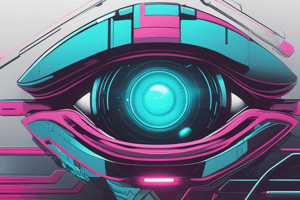Podcast
Questions and Answers
What is the primary function of cones in the eye?
What is the primary function of cones in the eye?
- Form sharp images
- Detect changes in light intensity
- Enable vision in dim light
- Responsible for color vision (correct)
Which part of the eye does not contain photoreceptors?
Which part of the eye does not contain photoreceptors?
- Pupil
- Lens
- Blind spot (correct)
- Iris
In response to increased light intensity, what happens to the pupil?
In response to increased light intensity, what happens to the pupil?
- Constricts (correct)
- Dilates
- Expands irregularly
- Remains the same
Which type of photoreceptor enables us to see in dim light but only in black and white?
Which type of photoreceptor enables us to see in dim light but only in black and white?
What is the function of the iris in the eye?
What is the function of the iris in the eye?
The cornea refracts light rays into the ______
The cornea refracts light rays into the ______
The fovea contains ______ but not rods
The fovea contains ______ but not rods
Cones work well only in ______ light
Cones work well only in ______ light
Rods enable us to see in ______ light but only in black and white
Rods enable us to see in ______ light but only in black and white
The optic nerve transmits impulses to the ______ when photoreceptors are stimulated
The optic nerve transmits impulses to the ______ when photoreceptors are stimulated
Flashcards are hidden until you start studying
Study Notes
Structure of the Eye
- Cornea refracts light rays into the eye
- Pupil allows light to enter the eye
- Iris controls the amount of light entering the eye using circular and radial muscles
- Blind spot does not contain photoreceptors, therefore not sensitive to light
- Optic nerve transmits impulses to the brain when photoreceptors are stimulated
Lens and Fovea
- Lens refracts light onto the retina and fine-tunes focusing by changing its curve and thickness
- Fovea contains cones but not rods
Photoreceptors
- There are two main types of photoreceptors: cones and rods
- Cones:
- Come in three types: red, blue, and green
- Work well only in bright light
- Responsible for color vision and formation of sharp images
- Rods:
- Stimulated even by very dim light
- Enable us to see in dim light but only in black and white
- More sensitive to light and movement than cones
Pupil Response to Increased Light Intensity
- Photoreceptors in the retina detect an increase in light intensity and are stimulated
- Sensory neurone in the optic nerve transmits nerve impulses to the brain
- Relay neurone in the brain transmits nerve impulses to the iris of the eye
- Radial muscles of the iris relax and circular muscles contract, causing the pupil to constrict
- Pupil constricts to reduce the amount of light entering the eye
Production of Focused Image
- Light rays enter the eye through the pupil
- Cornea refracts light rays into the eye
- Lens refracts light onto the retina and fine-tunes focusing by changing its curve and thickness
- Focused image is produced on the retina of the eye
Studying That Suits You
Use AI to generate personalized quizzes and flashcards to suit your learning preferences.




